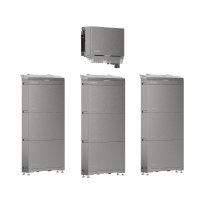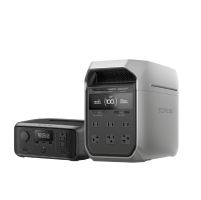Understanding the Energy Efficiency Rating System in the UK
If you're someone who's considering investing in a home solar system like the PowerOcean Home Battery Solution, then you’re obviously interested in the energy efficiency of your home. A system like this is can significantly improve where your property sits on the energy efficiency rating scale that’s used in the UK.
The world we live in focuses evermore on carbon neutrality, and the energy efficiency of your property matters. For example, if you're selling your home, you have to provide an Energy Performance Certificate (EPC) for potential buyers and when renting out a property, you need an EPC for landlords by law.
Believe it or not, only 41% of homes in the United Kingdom have an energy rating that meets the recommended level, but there's much you can do to improve yours. So, if you’re interested in learning a bit more about this house energy rating system, stay with us.
What kind of product or solution are you interested in?


So, What Is the UK’s Home Energy Efficiency Rating System?
Essentially, the UK Home Energy Rating System is used to assess the energy performance of each residential property. It’s also used as a measure against which to make improvements. The scale itself runs from A to G, and it breaks down something like this.
- A Rating - this is the highest rating possible and it typically means that the property has little to no environmental impact and enjoys very low energy bills. Usually, a house like this will have advanced insulation and renewable energy hardware installed.
- B Rating - also a high rating that rewards the owner with low energy costs and a reduced environmental impact. A property like this will have efficient heating and modern insulation.
- C Rating - a property with this energy rating is above average in the UK and will have a small impact on the environment and lower-than-average energy bills.
- D Rating - this is an average rating for home that will usually have basic insulation and standard heating systems.
- E Rating - now we get to the first below-average rating for properties that lack sufficient insulation and have less efficient heating systems.
- F Rating - this rating often relates to older, more established properties that have minimal insulation and outdated heating. As such, homes as inefficient as these often have a significant impact on the local environment.
- G Rating - at the bottom of the scale, this rating is the least efficient when it comes to losing heat and wasting energy.
This energy efficiency rating offers anyone buying a home a clear view of how it performs and the sort of heating bills they’ll face when living there. The certificate is provided by an energy assessor who’ll come around to your property and carry out an inspection.
How Is a Home's Energy Rating Calculated?
When you get your home assessed for energy performance, you'll find that it involves a detailed process that takes various factors into account. Here's how it works for homeowners across the United Kingdom, and it all begins with gathering information.
After booking your energy efficiency rating survey, an accredited energy assessor will visit your home in person. This on-site survey involves a thorough examination of a wide range of different aspects of your home. Let's dive in a little further.
Your Roof, Windows & Doors
Firstly, the most obvious external parts of your home will be assessed, which means your windows, doors and roof. As such, the quality and thickness of your roof will be scrutinised, as will your windows and doors, to check a) their condition and b) whether they're single, double or even triple-glazed.
Insulation Present
Another important element that's checked as part of your energy rating survey is the type and volume of insulation you have. In addition to fibreglass, wool or cellulose loft insulation, you may also have cavity wall insulation, and they'll all positively influence the rating you get.
Heating & Cooling Systems
Next, we have the systems that cool and heat your home and how efficiently they work. You might have gas central heating, storage heaters, or wood-fired stove burners, which are assessed along with any timers and thermostats they're connected to.
How Your Home Uses Energy
Naturally, how you use energy and where it comes from plays a big part in your overall energy efficiency rating. The types of appliances you have (keep reading to find out more on that), and whether you have energy-saving lightbulbs are taken into account.
Where you get your energy from is also of great importance, as homes powered by renewable sources such as solar panels and heat pumps also tend to get a high rating.
Your House Energy Rating & Improvement Recommendations
All of these major elements and more are taken by an accredited energy assessor and run through SAP (Standard Assessment Procedure) software, which calculates your home's energy efficiency rating or EER. You'll get a rating ranging from A to G, with A being the most efficient.
A residential EPC or EPC for Landlords can be very helpful, as it often also includes recommendations relating to how you might improve the rating of your home. Upgrading insulation, installing energy-efficient windows and adopting renewables like solar home batteries are among the most common suggestions.
How Your Appliances Can Influence Your Energy Rating
All the aspects we've mentioned so far have involved structural elements of your home. However, that's not the whole picture, as your appliance energy ratings can also have a big influence on how well your assessment goes. A significant portion of your energy efficiency rating is based on your white goods.
In the UK, energy ratings for dishwashers, cookers, microwaves and fridge energy ratings follow the same A-G scale, with each having a certain colour displayed on the outside (see below). Prior to 2021, an A+, A++, A+++ was employed.

When you have good appliance energy ratings, your overall energy consumption will be less, resulting in lower energy bills. Your washing machine, tumble dryer, refrigerator, and dishwasher all have a finite lifespan, and when they get old, they become inefficient, which can negatively impact your property's EPC rating.
“How Can I Improve My Home’s Energy Efficiency Rating?”
When your home has a good energy rating, you usually get to enjoy lower energy bills, improve your property’s value and reduce your impact on the environment. The good news is that there are some easily implemented ways you can improve yours.
You could, for example:
- · Invest in newer, better-rated home appliances.
- · Use smart tech that optimises energy usage based on when it’s needed
- · Consider having a home solar system fitted to your property
- · Install draft excluders and energy-efficient light bulbs
- · Add reflective foil behind your wall-mounted radiators
- · Insulate your hot water pipes to reduce heat loss
- · Get a programmable thermostat
Ultimately, these investments will eventually pay you back in savings, as well as improving your energy efficiency rating. With energy bills rising month after month, using less power can add up to a significant sum over time.
Significantly Enhance Your Energy Efficiency Rating With an EcoFlow Home Solar Battery Solution
As we’ve covered, your house energy rating matters. It makes your home cheaper to heat, easier to sell and worth more overall. What's more, there’s no more impactful way to boost your home’s energy rating than by putting your money into a home solar battery system.
In addition to making you less reliant on the national grid, Ecoflow home battery solutions allow you to have complete control over how you use energy. If you’d like to find out more about what’s on offer, just visit us today at https://homebattery.ecoflow.com/uk where you’ll discover our full range of options.
Alternatively, to get a free quote, simply click ‘Order Now’ on our homepage, after which one of our experts will get back to you. Our team has the know-how and experience to give you energy independence that will serve you well now and in the future.



